
The Guiana Shield is one of the three cratons of the South American Plate. It is a 1.7 billion-year-old Precambrian geological formation in northeast South America that forms a portion of the northern coast. The higher elevations on the shield are called the Guiana Highlands, which is where the table-like mountains called tepuis are found. The Guiana Highlands are also the source of some of the world's most well-known waterfalls such as Angel Falls, Kaieteur Falls and Kuquenan Falls.

A tepui, or tepuy, is a table-top mountain or mesa found in the Guiana Highlands of South America, especially in Venezuela and western Guyana. The word tepui means "house of the gods" in the native tongue of the Pemon, the indigenous people who inhabit the Gran Sabana.

Auyán Tepui, also spelled Ayan, is a tepui in Bolívar state, Venezuela. It is the most visited and one of the largest tepuis in the Guiana Highlands, with a summit area of 666.9 km2 (257.5 sq mi) and an estimated slope area of 715 km2 (276 sq mi). The unevenly heart-shaped summit plateau of Auyán-tepui is heavily inclined, rising from around 1,600 metres (5,200 ft) in the northwest to a maximum of 2,450 m (8,040 ft) in the southeast. It is incised from the north by a vast valley, the Cañón del Diablo, formed by the Churún River. The larger western portion of the plateau is partially forested, whereas the eastern part comprises mostly bare rock with only patchy vegetation cover. The mountain hosts a number of extensive cave systems.
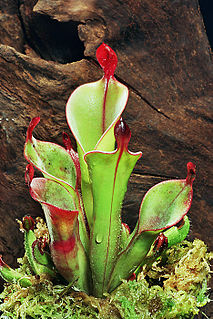
The genus Heliamphora contains 23 species of pitcher plants endemic to South America. The species are collectively known as sun pitchers, based on the mistaken notion that the heli of Heliamphora is from the Greek helios, meaning "sun". In fact, the name derives from helos, meaning marsh, so a more accurate translation of their scientific name would be marsh pitcher plants. Species in the genus Heliamphora are carnivorous plants that consist of a modified leaf form that is fused into a tubular shape. They have evolved mechanisms to attract, trap, and kill insects; and control the amount of water in the pitcher. At least one species produces its own proteolytic enzymes that allows it to digest its prey without the help of symbiotic bacteria.

Epidendrum, abbreviated Epi in the horticultural trade, is a large neotropical genus of the orchid family. With more than 1,500 species, some authors describe it as a mega-genus. The genus name refers to its epiphytic growth habit.

Coilostylis is a genus of orchids. It was split off from the "supergenus" Epidendrum in 2004 although the Kew currently does not recognize this genus. This genus features pseudobulbs, large bracts around the flowers, and flowers that are typically resupinate, with the trilobate lip adnate to the column and having a long thin midlobe. It is not unusual for this genus to produce keikes.
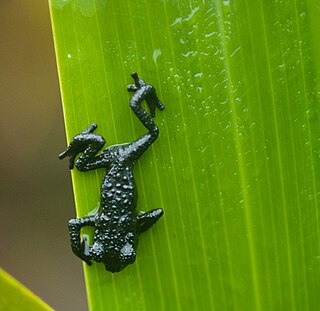
Oreophrynella, commonly known as bush toads, is a genus of true toads native to the tepuis of southern Venezuela and adjacent Guyana. The distribution of some species is restricted to a couple of tepuis or even a single tepui, as in the case of Oreophrynella weiassipuensis, which occurs on Wei-Assipu-tepui.

Heliamphora nutans is a species of marsh pitcher plant native to the border area between Venezuela, Brazil and Guyana, where it grows on several tepuis, including Roraima, Kukenán, Yuruaní, Maringma, and Wei Assipu. Heliamphora nutans was the first Heliamphora to be described and is the best known species.
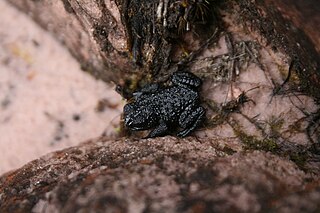
Oreophrynella nigra, or pebble toad, is a species of toad in the family Bufonidae. It is endemic to the Guiana Highlands in Bolívar State, Venezuela, and known from two tepuis, Kukenan-tepui and Yuruani-tepui, both belonging to the Eastern Tepuis.

Epidendrum microphyllum is a species of tropical orchid in the genus Epidendrum with non-resupinate flowers.
Chimantaea is a genus of flowering plants in the aster family, Asteraceae.

The tepui toucanet or Whitely's toucanet is a South American species of bird in the family Ramphastidae. It is native to the humid forests of the tepuis and other highlands of the Guiana Shield. It was formerly considered conspecific with the chestnut-tipped toucanet.

The Chimantá Massif is a highly fragmented complex of tepuis in Bolívar state, Venezuela. The massif comprises around 11 tepuis and has a total summit area of 615 km2 (237 sq mi) and an estimated slope area of 915 km2 (353 sq mi). It is divided in two by the Río Tírica, with the northern section being both larger and higher. The massif is notable for its high species richness and for its varied habitat types. It reaches an elevation of 2,698 metres (8,852 ft) on its highest peak, Murey-tepui. The massif is situated entirely within the bounds of Canaima National Park. It hosts extensive cave systems, including the world's largest known quartzite cave, Cueva Charles Brewer, named after discoverer Charles Brewer-Carías. The processes behind their speleogenesis are the subject of some debate.

Wei-Assipu-tepui, also known as Little Roraima or Roraimita, is a minor tepui of the Eastern Tepuis chain. It lies just off the northeastern flank of Roraima-tepui, directly on the border between Brazil and the disputed Guayana Esequiba territory, claimed by Venezuela but controlled by Guyana, and very close to the tripoint of all three countries. The mountain is known for its extensive cave systems, with one extending for over a kilometre.
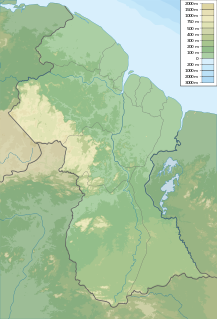
Maringma-tepui, also written Mount Maringma and historically known as Mount Marima, is a small tepui of the Pacaraima Mountains in Cuyuni-Mazaruni, Guyana. It is known as Malaima-tepui in the local Akawaio language. Most published sources place it just inside Guyanese territory, very close to the border with Brazil, and around 17 kilometres (11 mi) east of Roraima-tepui. However, the mountain remains the subject of considerable toponymic confusion and its name has been applied to at least one other nearby peak.
Leslie Andrew Garay, born Garay László András, was an American botanist. He was the curator of the Oakes Ames Orchid Herbarium at Harvard University, where he succeeded Charles Schweinfurth in 1958. In 1957 he was awarded a Guggenheim Fellowship.

Ceuthomantis is a small genus of craugastorid frogs, also treated as comprising their own monogeneric family Ceuthomantidae. They are found in the southern and eastern parts of the Guiana Highlands in Venezuela, Guyana, and Brazil. The generic name is derived from the Greek noun mantis, which means treefrog, and adjective keuthos, which means hidden, in allusion to the hidden existence of this genus in the tepuis of the Guiana Shield.
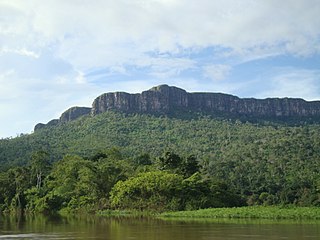
The Guayanan Highlands moist forests (NT0124) is an ecoregion in the south of Venezuela and the north of Brazil and in Guyana, Suriname, French Guiana. It is in the Amazon biome. It encompasses an upland region with diverse fauna and flora, which contains dramatic tepuis, or sandstone table mountains. The region has been inaccessible in the past and is generally fairly intact, apart from the north and northeast where large scale agriculture, ranching and mining operations are steadily encroaching on the ecosystem. New roads are opening the interior to logging, and planned dams will have a drastic impact on the riparian zones.
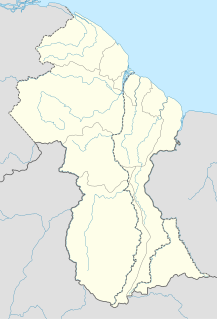
Paruima is an indigenous village of Arecuna Amerindians in the Cuyuni-Mazaruni Region of Guyana. The village was founded as a mission of the Seventh-day Adventist Church. It is the only Arecuna speaking community in Guyana.
Acanthostachys calcicola is a species of plant discovered in a limestone rock in the Brazilian state of Tocantins.

















